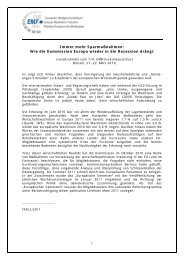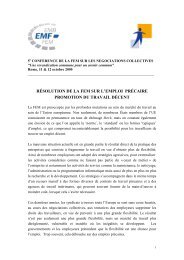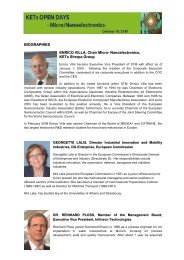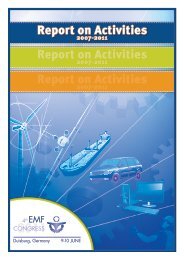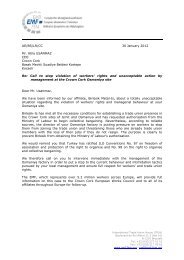Diversity Management in the ICT Industry Challenges ... - EMF-FEM
Diversity Management in the ICT Industry Challenges ... - EMF-FEM
Diversity Management in the ICT Industry Challenges ... - EMF-FEM
You also want an ePaper? Increase the reach of your titles
YUMPU automatically turns print PDFs into web optimized ePapers that Google loves.
<strong>Diversity</strong> <strong>Management</strong> <strong>in</strong> <strong>the</strong> <strong>ICT</strong> <strong>Industry</strong><strong>Challenges</strong> and Issues for Social DialogueReport prepared for Union Network InternationalSeptember 2007Dr Juliet WebsterWork and Equality Research22 Northchurch TerraceLondon N1 4EGTel: +44 20 72 49 25 04Email: equality.research@debeauvoir.co.uk
ContentsCONTENTS........................................................................................................................................................................21. INTRODUCTION..........................................................................................................................................................12. THE CHALLENGES.....................................................................................................................................................32.1 LOW LEVELS OF RECRUITMENT AND RETENTION OF WOMEN....................................................................................................32.2 DISCRIMINATION AGAINST OLDER WORKERS.........................................................................................................................52.3 THE USE OF MIGRANT LABOUR..........................................................................................................................................62.4 THE COSTS OF POOR DIVERSITY.........................................................................................................................................73. GOOD PRACTICE IN DIVERSITY MANAGEMENT AND THE ROLE OF SOCIAL DIALOGUE..............103.1 RECRUITMENT AND SELECTION........................................................................................................................................103.2 DEVELOPMENT AND RETENTION......................................................................................................................................123.3 FLEXIBLE RETIREMENT..................................................................................................................................................143.4 BUILDING INCLUSIVE ORGANISATIONAL CULTURES..............................................................................................................153.5 PLANNING, MONITORING AND EVALUATION........................................................................................................................163.6 CONCLUDING COMMENT................................................................................................................................................164. REFERENCES.............................................................................................................................................................18
1. IntroductionThe <strong>ICT</strong> sector is one of <strong>the</strong> most dynamic areas of <strong>the</strong> European economy, a key source ofgrowth and employment. 5.3 million people were employed <strong>in</strong> <strong>the</strong> sector <strong>in</strong> 2006, <strong>in</strong> 520,000enterprises (EU <strong>ICT</strong> Task Force 2006). This amounts to between 2% and 4% of <strong>the</strong> totalemployment <strong>in</strong> member states (e-skills UK 2007).But <strong>ICT</strong> skills and labour are <strong>in</strong> short supply, and this problem is becom<strong>in</strong>g progressivelymore serious, with an <strong>in</strong>creas<strong>in</strong>g deficit between labour supply and demand. It has beenpredicted that <strong>the</strong>re will be a gap of nearly 16% between supply of and demand for <strong>ICT</strong> skills<strong>in</strong> <strong>the</strong> EU by 2008, with a gap of 20% <strong>in</strong> some EU member states, particularly <strong>the</strong> easternones (IDC 2005, quoted <strong>in</strong> Healy and Schwarz-Woelzl 2007). Employ<strong>in</strong>g organisationsreport considerable difficulties <strong>in</strong> recruit<strong>in</strong>g IT staff, particularly SMEs <strong>in</strong> structurally weakregions and organisations without a strong ‘employer brand’ (Barrow and Mosley 2005;Healy and Schwarz-Woelzl 2007).There is also a grow<strong>in</strong>g demand for ‘soft’ skills <strong>in</strong> <strong>ICT</strong> work; <strong>the</strong>se are <strong>in</strong>creas<strong>in</strong>glyemphasised <strong>in</strong> recruitment and selection processes. ‘Soft skills’ generally refer to: bus<strong>in</strong>essskills, communications skills, team-work<strong>in</strong>g skills, competencies, personal attributes,<strong>in</strong>dividual qualities, transferable skills, social skills, <strong>in</strong>terpersonal skills - all important forclient-fac<strong>in</strong>g work and for manag<strong>in</strong>g outsourc<strong>in</strong>g relationships, on which <strong>the</strong> <strong>ICT</strong> sector isstrongly dependent.The problem of skills shortages is one of several compell<strong>in</strong>g reasons for practis<strong>in</strong>g diversitymanagement <strong>in</strong> <strong>ICT</strong>. There is a need to widen <strong>the</strong> pool of labour by draw<strong>in</strong>g upon <strong>the</strong> fulllabour force, <strong>in</strong>clud<strong>in</strong>g women, older workers and o<strong>the</strong>r groups who are conventionallybypassed <strong>in</strong> <strong>ICT</strong> employment. <strong>Diversity</strong> management can also deliver:• Fuller utilisation of <strong>the</strong> skills of <strong>the</strong> workforce• Better customer relationship management and ability to access new custom by betterreflect<strong>in</strong>g <strong>the</strong> diversity of <strong>the</strong> market• Improvement of organisational cultures and fuller engagement of employees• Protection aga<strong>in</strong>st discrim<strong>in</strong>ation claims and contract compliance• Commitment to social justice or to <strong>the</strong> pr<strong>in</strong>ciples of corporate social responsibility.This report exam<strong>in</strong>es <strong>the</strong> challenges for diversity <strong>in</strong> <strong>the</strong> <strong>ICT</strong> sector, with a particular focus onwomen, older workers and migrant workers. Gender and age diversity issues are welldocumentedand closely <strong>in</strong>ter-related; similar stereotypes and discrim<strong>in</strong>atory practices areoften used <strong>in</strong> relation to women and older workers, and some of <strong>the</strong> remedies are similar. Thechallenge of migrant labour is somewhat different: it is a relatively recent development <strong>in</strong> <strong>ICT</strong>work, and one which it is sometimes feared will undercut <strong>the</strong> employment, terms andconditions of <strong>in</strong>digenous workers. There is a danger, <strong>the</strong>refore, of treat<strong>in</strong>g migrant workers asthreaten<strong>in</strong>g established workforces - be<strong>in</strong>g used, <strong>in</strong> fact, to substitute for proper diversitymanagement by offer<strong>in</strong>g a ready skills supply at low cost. This is a difficult issue fordiversity professionals and trade unions alike to manage and respond to. Never<strong>the</strong>less,diversity management should not be based on protectionism of one workforce group at <strong>the</strong>expense of ano<strong>the</strong>r; ra<strong>the</strong>r it is concerned with <strong>the</strong> <strong>in</strong>clusion and protection of all members of<strong>the</strong> workforce. This pr<strong>in</strong>ciple must be at <strong>the</strong> forefront of all diversity th<strong>in</strong>k<strong>in</strong>g.<strong>Diversity</strong> <strong>Management</strong> <strong>in</strong> <strong>ICT</strong> Page 1
2. The <strong>Challenges</strong>There are two key groups <strong>in</strong> <strong>the</strong> labour market who are substantially under-represented <strong>in</strong> <strong>ICT</strong>jobs, <strong>the</strong> improved recruitment and retention of whom is now treated as one of <strong>the</strong> ma<strong>in</strong>solutions to <strong>the</strong> <strong>ICT</strong> skills deficit: women and older workers. Why are <strong>the</strong>se workers notpresent <strong>in</strong> <strong>ICT</strong> work <strong>in</strong> similar proportions to <strong>the</strong>ir presence <strong>in</strong> <strong>the</strong> wider labour force?2.1 Low levels of recruitment and retention of womenEver s<strong>in</strong>ce <strong>ICT</strong>s first became a feature of economic and work<strong>in</strong>g life, women have beennoticeably under-represented <strong>in</strong> <strong>ICT</strong> work, particularly at senior levels (Cockburn 1985; Gaio1995; Webster 1997). Women enter <strong>in</strong> <strong>ICT</strong> work <strong>in</strong> small proportions.In all countries, women’s representation <strong>in</strong> <strong>ICT</strong> work lags well beh<strong>in</strong>d <strong>the</strong>ir representation <strong>in</strong><strong>the</strong> labour market as a whole. In Australia and <strong>the</strong> US, <strong>the</strong>y make up around 20% of <strong>ICT</strong>employees. In <strong>the</strong> EU27, women made up 19% of <strong>ICT</strong> staff <strong>in</strong> 2004 (Eurostat 2007). In somecountries <strong>the</strong>y account for as little as 6% of <strong>ICT</strong> workers (E-Skills UK 2007). Fur<strong>the</strong>rmore,<strong>the</strong> numbers of women enter<strong>in</strong>g <strong>ICT</strong> work have not <strong>in</strong>creased over time (<strong>in</strong> some countries<strong>the</strong>y have decreased), and <strong>the</strong>re are concerns that policy efforts and <strong>in</strong>itiatives to attract morewomen <strong>in</strong>to <strong>ICT</strong> over <strong>the</strong> past twenty years have been largely unsuccessful. As Figure 1shows, while <strong>the</strong> numbers of men employed <strong>in</strong> <strong>ICT</strong> work have <strong>in</strong>creased <strong>in</strong> recent years,female employment has rema<strong>in</strong>ed static, with periods of decl<strong>in</strong>e. In <strong>the</strong> UK, <strong>the</strong> number ofwomen employed as comput<strong>in</strong>g professionals halved <strong>in</strong> <strong>the</strong> four years between 1999 and2003, so <strong>the</strong> small peak <strong>in</strong> women’s employment was very short-lived (Platman and Taylor2004).Figure 1: Number of people employed <strong>in</strong> <strong>ICT</strong> occupations <strong>in</strong> EU-27, 2004Source: Eurostat, 2007.<strong>Diversity</strong> <strong>Management</strong> <strong>in</strong> <strong>ICT</strong> Page 3
Why are women so poorly represented <strong>in</strong> <strong>ICT</strong> work? And what are <strong>the</strong> challenges that needto be addressed <strong>in</strong> order to improve this state of affairs?Images of <strong>ICT</strong> WorkDespite achiev<strong>in</strong>g well <strong>in</strong> maths, science, and technology subjects at school, women do not goon to enter <strong>ICT</strong> work <strong>in</strong> large numbers (George 2003). On <strong>the</strong> supply side, women’s image of<strong>ICT</strong> work is poor. The image of <strong>ICT</strong> work still held by many women is that it is conf<strong>in</strong>ed tosedentary activity <strong>in</strong> front of a computer screen, <strong>in</strong>volves little or no social <strong>in</strong>teraction, and istypically performed by ‘nerdy’ young men with few social skills. Research suggests thatwomen and girls have little awareness of <strong>the</strong> potential variety of <strong>ICT</strong> work, particularly itsapplied aspects (Valenduc et al 2004; Webster 2006). Considerable policy effort has beendevoted to chang<strong>in</strong>g this image through ‘pipel<strong>in</strong>e <strong>in</strong>itiatives’ - offer<strong>in</strong>g girls and womenopportunities to experience <strong>ICT</strong> work and workplaces at first hand.Employment Practices <strong>in</strong> <strong>ICT</strong> WorkOn <strong>the</strong> demand side, employment arrangements persist which effectively discrim<strong>in</strong>ate aga<strong>in</strong>stand certa<strong>in</strong>ly disadvantage women, deterr<strong>in</strong>g <strong>the</strong>m from enter<strong>in</strong>g this employment andprompt<strong>in</strong>g <strong>the</strong>ir early leav<strong>in</strong>g of it. Despite be<strong>in</strong>g at <strong>the</strong> cutt<strong>in</strong>g edge of European economicgrowth and <strong>in</strong>novation, parts of <strong>the</strong> <strong>ICT</strong> <strong>in</strong>dustry are surpris<strong>in</strong>gly out-dated <strong>in</strong> <strong>the</strong>iremployment practices.• Recruitment – <strong>ICT</strong> employers recognise that <strong>the</strong>y have enormous difficulties recruit<strong>in</strong>gfemale staff, <strong>in</strong>deed staff of ei<strong>the</strong>r sex, yet <strong>the</strong>y still turn to traditional talent pools as <strong>the</strong>irprimary means of recruitment. There are still few examples of organisations recruit<strong>in</strong>gfrom non-traditional parts of <strong>the</strong> labour market, such as women return<strong>in</strong>g to work after amaternity, career or car<strong>in</strong>g break. The challenge is to develop recruitment strategies andpractices target<strong>in</strong>g diverse groups which are conventionally bypassed.• Retention – <strong>the</strong> employment conditions <strong>in</strong> <strong>ICT</strong> work are often unfriendly to women,particularly to women with children or o<strong>the</strong>r car<strong>in</strong>g responsibilities. The lack of flexiblework<strong>in</strong>g arrangements and particularly <strong>the</strong> long work<strong>in</strong>g hours <strong>in</strong> <strong>ICT</strong> have been widelycriticised as effectively exclud<strong>in</strong>g and o<strong>the</strong>r employees who cannot or do not wish to work<strong>in</strong> this way. Travel to clients and on-site work<strong>in</strong>g can also be difficult. Womenconsequently drop out of <strong>ICT</strong> employment <strong>in</strong> particularly large numbers after maternity.They also leave <strong>in</strong> significant numbers <strong>in</strong> <strong>the</strong>ir 40s and 50s, apparently <strong>in</strong> order to rega<strong>in</strong>control over <strong>the</strong>ir work<strong>in</strong>g hours and to work more flexibly (George 2003; DTI 2005).The challenge, <strong>the</strong>n, is to offer work<strong>in</strong>g time arrangements, as well as tra<strong>in</strong><strong>in</strong>g anddevelopment opportunities, which support, value and susta<strong>in</strong> <strong>ICT</strong> workers at all po<strong>in</strong>ts <strong>in</strong><strong>the</strong>ir lives and careers, and not only <strong>the</strong> young and unattached. <strong>Diversity</strong> policies <strong>in</strong> thisarea need to <strong>in</strong>tersect around gender and age, where problems are strongly <strong>in</strong>terconnected.• The gender pay gap – comparisons of women’s and men’s pay shows a gender pay gap of20% <strong>in</strong> <strong>the</strong> UK <strong>ICT</strong> <strong>in</strong>dustry (Glover 2007). Moreover, <strong>the</strong>re is pay secrecy <strong>in</strong> <strong>ICT</strong>employment, partly related to <strong>the</strong> absence of collective barga<strong>in</strong><strong>in</strong>g and to <strong>the</strong><strong>in</strong>dividualisation of employment relations, <strong>in</strong>clud<strong>in</strong>g pay barga<strong>in</strong><strong>in</strong>g (Valenduc et al2004). However, pay equality and pay transparency are decisive factors encourag<strong>in</strong>gwomen to work for certa<strong>in</strong> companies; <strong>in</strong> a survey of employees’ perceptions of equal pay,<strong>Diversity</strong> <strong>Management</strong> <strong>in</strong> <strong>ICT</strong> Page 4
Creativity is also partly driven by market pressure and market awareness, <strong>in</strong> particular anability to assess customer requirements and respond to <strong>the</strong>m. This, as we have already seen,is severely challenged <strong>in</strong> low diversity organisations whose ability to connect with <strong>the</strong>ircustomer or community bases is restricted. F<strong>in</strong>ally, <strong>the</strong>re is <strong>the</strong> reputational risk of notmanag<strong>in</strong>g diversity. Increas<strong>in</strong>g prom<strong>in</strong>ence is be<strong>in</strong>g given to organisations which havepositive and proactive diversity policies, <strong>in</strong> <strong>the</strong> mass media, <strong>in</strong> good practice guides, <strong>in</strong>reports, <strong>in</strong> policy documents. A noticeably poor diversity record compromises <strong>the</strong> reputationof an organisation – with potential employees, but also with suppliers and customers. Given<strong>the</strong> importance of customer relationship management <strong>in</strong> <strong>the</strong> <strong>ICT</strong> sector, this is a competitivethreat.Discrim<strong>in</strong>ation has f<strong>in</strong>ancial costsThe costs of discrim<strong>in</strong>at<strong>in</strong>g aga<strong>in</strong>st particular employee groups are difficult to quantify, butattempts have been made <strong>in</strong> relation to age discrim<strong>in</strong>ation. The UK Department of Trade and<strong>Industry</strong> has estimated that age discrim<strong>in</strong>ation costs all British employers £750m per year, and<strong>the</strong> Chartered Institute for Personnel Development estimates <strong>the</strong> labour turnover cost of as<strong>in</strong>gle manager at £12,500. On <strong>the</strong> o<strong>the</strong>r hand, HR Benchmark<strong>in</strong>g <strong>in</strong> Australia found that <strong>the</strong>net recruitment benefit of hir<strong>in</strong>g workers aged 45+ was of $1424 <strong>in</strong> 1999 (quoted <strong>in</strong> Healyand Schwarz-Woelzl 2007).Organisations which discrim<strong>in</strong>ate on <strong>the</strong> basis of age or sex risk <strong>in</strong>curr<strong>in</strong>g <strong>the</strong> cost ofemployment tribunals. There are also contract compliance obligations on organisations whichoblige <strong>the</strong>m to demonstrate <strong>the</strong>ir equality policies and practices to be eligible as suppliers.Those which cannot do so risk los<strong>in</strong>g bus<strong>in</strong>ess. In all, <strong>the</strong>refore, <strong>the</strong>re are compell<strong>in</strong>g reasonsfor improv<strong>in</strong>g diversity:• Recruit<strong>in</strong>g from a diverse base helps to address skills shortages.• There is an <strong>in</strong>creased chance of hir<strong>in</strong>g high quality staff when target<strong>in</strong>g wider and morediverse groups.• This helps organisations to support and extent <strong>the</strong> <strong>in</strong>novative potential of <strong>the</strong>ir employees,which is critical <strong>in</strong> knowledge-based work• This <strong>in</strong> turn is likely to raise <strong>the</strong> skills levels with<strong>in</strong> an organisation’s workforce overall.There are virtuous circle advantages associated with diverse teams; for example, olderworkers tend to pass on <strong>the</strong>ir experience to o<strong>the</strong>rs and act as <strong>in</strong>formal coaches andmentors• <strong>Diversity</strong> management improves an organisation’s ability to respond to its exist<strong>in</strong>g(diverse) customer or user base, and to reach potential new markets• <strong>Diversity</strong> management means engag<strong>in</strong>g and <strong>in</strong>volv<strong>in</strong>g all employees, and <strong>the</strong>re issubstantial evidence to show that employee <strong>in</strong>volvement plays a crucial role <strong>in</strong> improv<strong>in</strong>gorganisational <strong>in</strong>novation and performance as well as employee satisfaction (Rose 2007).We now look at good practice <strong>in</strong> diversity management and <strong>the</strong> contribution that socialdialogue can make to <strong>the</strong> process.<strong>Diversity</strong> <strong>Management</strong> <strong>in</strong> <strong>ICT</strong> Page 9
3. Good Practice <strong>in</strong> <strong>Diversity</strong> <strong>Management</strong> and<strong>the</strong> Role of Social Dialogue<strong>Diversity</strong> management is concerned with attract<strong>in</strong>g <strong>the</strong> widest possible range of employees,treat<strong>in</strong>g all members of <strong>the</strong> workforce as an asset, and mak<strong>in</strong>g best use of <strong>the</strong>ir potential <strong>in</strong>order to maximise <strong>the</strong> capacity of <strong>the</strong> organisation and, simultaneously, <strong>the</strong> job satisfaction of<strong>the</strong> employee. In seek<strong>in</strong>g to fully engage and reward all employees, it is fundamentallyconcerned with <strong>the</strong> same project as social dialogue – <strong>in</strong>volv<strong>in</strong>g employees, giv<strong>in</strong>g <strong>the</strong>m avoice, and ensur<strong>in</strong>g that <strong>the</strong>y are valued and rewarded. What, <strong>the</strong>n, constitutes good practice<strong>in</strong> diversity management and how can social dialogue, or <strong>in</strong>deed <strong>the</strong> <strong>in</strong>volvement of tradeunion and employee representatives, contribute to it?Accord<strong>in</strong>g to <strong>the</strong> <strong>Diversity</strong>@Work project (www.diversityatwork.net), it is vital to tacklediversity management proactively and positively, as an opportunity to improve organisationallearn<strong>in</strong>g and practice, ra<strong>the</strong>r than simply as a legal or o<strong>the</strong>r imperative. Such a proactiveapproach requires social dialogue and makes trade unions and employee representatives keyplayers <strong>in</strong> <strong>the</strong> process of establish<strong>in</strong>g and conduct<strong>in</strong>g diversity <strong>in</strong>itiatives.Proactive diversity management also means treat<strong>in</strong>g diversity as a set of <strong>in</strong>tersect<strong>in</strong>g issues.Discrim<strong>in</strong>ation often occurs across several dimensions simultaneously (discrim<strong>in</strong>ation bygender and age for example), and so too legislation and good practice should address diversityon multiple fronts. Integrated diversity <strong>in</strong>itiatives ensure that diversity is managed efficientlyand, above all, consistently across workforce groups.3.1 Recruitment and selectionRecruit<strong>in</strong>g for a diverse workforce requires th<strong>in</strong>k<strong>in</strong>g beyond conventional recruitmentmethods and labour markets, and organis<strong>in</strong>g recruitment processes to attract groups who arenormally missed. A first step <strong>in</strong> this process <strong>in</strong>volves review<strong>in</strong>g exist<strong>in</strong>g recruitment andselection processes, tools and <strong>in</strong>struments, which can be done through social dialogue.Look<strong>in</strong>g upstream <strong>in</strong> <strong>the</strong> ‘talent pipel<strong>in</strong>e’ to attract girls <strong>in</strong>to <strong>ICT</strong> employmentSome companies do outreach activities with girls at primary and secondary school, such asoffer<strong>in</strong>g work taster days. The European Commission has this year launched a shadow<strong>in</strong>gexercise, <strong>in</strong> which young women accompanied for one day a female role model <strong>in</strong> a lead<strong>in</strong>gtechnology company. In <strong>the</strong> UK, <strong>the</strong> IT Sector Skills Council, e-skills UK, operates an<strong>in</strong>itiative entitled Computer Clubs for Girls, which is designed for 11-14 year olds to learnmore about <strong>the</strong> reality of comput<strong>in</strong>g work through web-based activities.Attract<strong>in</strong>g ‘occupational returners’, <strong>in</strong>clud<strong>in</strong>g women and older workers, back <strong>in</strong>to <strong>ICT</strong>work after a break<strong>Diversity</strong> management <strong>in</strong>cludes work<strong>in</strong>g with organisations which can access returners. TheEQUAL project ‘JIVE’ runs a “Return” service which aims to <strong>in</strong>crease <strong>the</strong> numbers of womenreturn<strong>in</strong>g to <strong>ICT</strong> careers. It works closely with a job placement service, to f<strong>in</strong>d employmentfor women returners.Advertis<strong>in</strong>g to reach <strong>the</strong> broadest audienceJobs should be advertised <strong>in</strong> media likely to be accessed by m<strong>in</strong>ority groups as well as <strong>in</strong>those accessed by predom<strong>in</strong>ant workforce groups. Some companies advertise <strong>in</strong> women’smagaz<strong>in</strong>es or <strong>in</strong> <strong>the</strong> specialist ethnic m<strong>in</strong>ority press, to reach <strong>the</strong>se target groups. Although<strong>Diversity</strong> <strong>Management</strong> <strong>in</strong> <strong>ICT</strong> Page 10
onl<strong>in</strong>e selection is be<strong>in</strong>g <strong>in</strong>creas<strong>in</strong>gly widely used, <strong>the</strong>re are concerns that it may not helprecruitment diversity, as <strong>the</strong> <strong>in</strong>ternet is ma<strong>in</strong>ly used by certa<strong>in</strong> types of job seekers alreadywell represented <strong>in</strong> <strong>ICT</strong> work - younger, male, already <strong>in</strong> employment, as well as be<strong>in</strong>gfrequent job changers.Signall<strong>in</strong>g that applications from people of all ages and both sexes are welcomeExplicitly stat<strong>in</strong>g an organisation’s commitment to recruit people from under-representedgroups is an important way of signall<strong>in</strong>g to potential applicants that <strong>the</strong> employer iscommitted to diverse employment and diversity management. Employ<strong>in</strong>g organisationswhich can demonstrate that <strong>the</strong>y practise diversity management have been shown be moreattractive to potential employees, particularly highly educated women and ethnic m<strong>in</strong>orityapplicants (Ng and Burke 2005).Creat<strong>in</strong>g open and transparent recruitment processesThere is substantial evidence and experience to show that transparent recruitment andpromotion processes are among <strong>the</strong> most important contribut<strong>in</strong>g factors promot<strong>in</strong>g equality <strong>in</strong>organisations. Specifically, <strong>the</strong>se <strong>in</strong>clude <strong>the</strong> publication of clear job descriptions and personspecifications, and open selection processes with clear criteria for decision-mak<strong>in</strong>g. Often<strong>the</strong>re is little or no transparency about how or why recruitment decisions are taken.Establish<strong>in</strong>g diverse <strong>in</strong>terview panels so that no s<strong>in</strong>gle group is over- or under-representedon panelsAga<strong>in</strong>, this strongly signals to applicants and exist<strong>in</strong>g employees that <strong>the</strong> organisationoperates open recruitment processes and sets out to make all applicants feel comfortable aboutapply<strong>in</strong>g for employment.Chang<strong>in</strong>g selection criteria by remov<strong>in</strong>g age and sex from applications process, and us<strong>in</strong>ga competency-based approach to job requirementsEmployers are sometimes reluctant to employ staff without current <strong>ICT</strong> skills. Whilst up-todateskills are clearly important, <strong>the</strong>re is a risk of employers overlook<strong>in</strong>g a potentially largetalent pool and deterr<strong>in</strong>g potentially strong applicants. Us<strong>in</strong>g a competency-based approachto recruitment allows applicants to demonstrate transferable skills ra<strong>the</strong>r than length of serviceor even current qualifications. It is recognised as be<strong>in</strong>g helpful to returners who often lackconfidence <strong>in</strong> <strong>the</strong>ir skills and tend to exclude <strong>the</strong>mselves from apply<strong>in</strong>g for positions (Glover2007). Chang<strong>in</strong>g selection criteria to promote diversity also means explicitly valu<strong>in</strong>g, <strong>in</strong> <strong>the</strong>selection process, <strong>the</strong> qualities which diverse groups br<strong>in</strong>g to <strong>the</strong> workplace. In <strong>the</strong> case ofolder workers, <strong>the</strong>se may <strong>in</strong>clude stability, experience, and customer orientation. In <strong>the</strong> caseof women, <strong>the</strong>y may <strong>in</strong>clude <strong>in</strong>terpersonal skills, application orientation, and ability to mixskills and tasks.Employees and <strong>the</strong>ir representatives could fruitfully be <strong>in</strong>volved <strong>in</strong> <strong>the</strong> process of revis<strong>in</strong>g jobdescriptions and person specifications, as <strong>the</strong>y are likely to have grounded experience of <strong>the</strong>actual competencies, <strong>in</strong>clud<strong>in</strong>g ‘soft’ skills, needed for certa<strong>in</strong> <strong>ICT</strong> roles.Us<strong>in</strong>g <strong>the</strong> ethical reputation of <strong>the</strong> organisation as a recruitment toolMany organisations recognise <strong>the</strong> importance of reputation for attract<strong>in</strong>g high-qualityapplicants, and are keen to promote <strong>the</strong>ir ‘employer brand’ as diverse organisations or goodemployers. League tables and award schemes such as ‘Where Women Want to Work’ and‘100 Best Places to Work’ help to raise <strong>the</strong> profile of organisations who pursue good practice,for example, <strong>in</strong> flexible work<strong>in</strong>g or diversity management. There is evidence thatdemonstrable diversity management practices are an important factor <strong>in</strong> <strong>the</strong> decision-mak<strong>in</strong>g<strong>Diversity</strong> <strong>Management</strong> <strong>in</strong> <strong>ICT</strong> Page 11
criteria applied by highly educated female applicants (Ng and Burke 2005). Reputation is aparticularly valuable recruitment tool for employ<strong>in</strong>g organisations which are not able to offer<strong>the</strong> same high rates of pay as those offered by large, private sector employers. The publicsector <strong>in</strong> particular has a strong reputation for a commitment, and <strong>in</strong>deed an obligation to,manage diversity, and this is particularly attractive to applicants with children, such as womenreturners.Conduct<strong>in</strong>g recruitment and employment auditsA key element of manag<strong>in</strong>g diversity is collect<strong>in</strong>g data on employment patterns <strong>in</strong> anorganisation. Hav<strong>in</strong>g simple, quantitative data on recruitment and progression is extremelyimportant, because it gives a clear picture of where <strong>in</strong>equalities are to be found. The projectDemografie-Initiative provides a method for organisations to assess <strong>the</strong>ir employmentprofile, and offers recommendations for remedial actions (quoted <strong>in</strong> Healy and Schwarz-Woelzl 2007)). Given <strong>the</strong> gender pay gap that exists <strong>in</strong> <strong>the</strong> sector, conduct<strong>in</strong>g a pay audit at<strong>the</strong> same time is likely to contribute significantly to <strong>the</strong> perceived transparency of anorganisation and its will<strong>in</strong>gness to tackle areas of <strong>in</strong>equality. This has been shown to motivateand encourage women to work for companies that do so (Intellect 2006).Trade unions representatives can play a vital role <strong>in</strong> <strong>the</strong> data collection and analysis process,with <strong>the</strong>ir management counterparts. It is important to <strong>in</strong>clude not only employ<strong>in</strong>g but alsocontract<strong>in</strong>g organisations <strong>in</strong> any assessment of employment patterns. (Organisationscontracted to <strong>the</strong> public sector are <strong>in</strong> any case obliged to demonstrate <strong>the</strong>ir equality plans, so<strong>the</strong> audit process can be used to support <strong>the</strong>m <strong>in</strong> do<strong>in</strong>g so.) Social dialogue offers a usefularena <strong>in</strong> which data can be reviewed and possible actions discussed.3.2 Development and RetentionEnsur<strong>in</strong>g that lifelong learn<strong>in</strong>g is available to all employeesThe development and ma<strong>in</strong>tenance of professional skills is a vital element <strong>in</strong> <strong>the</strong> cont<strong>in</strong>u<strong>in</strong>gcontribution of <strong>ICT</strong> workers to <strong>the</strong>ir organisation’s performance. Yet <strong>the</strong>re are groups ofworkers who are often excluded from or unable to participate <strong>in</strong> <strong>in</strong>itiatives which keep <strong>the</strong>irskills current and <strong>the</strong>se <strong>in</strong>clude women on maternity leave, part-time workers, older workers,and o<strong>the</strong>r types of organisational returners. Good practice <strong>in</strong> diversity management <strong>in</strong>cludesensur<strong>in</strong>g that all workers are able to participate <strong>in</strong> skills development and ma<strong>in</strong>tenance. Thereare both targeted and universal <strong>in</strong>itiatives that are useful <strong>in</strong> this respect. Targeted schemes areuseful for reach<strong>in</strong>g members of <strong>the</strong> labour force who have particular development needs andrequirements. They are also helpful for women on maternity leave and o<strong>the</strong>rs on careerbreaks who are away from <strong>the</strong> workplace, and who can be <strong>in</strong>cluded <strong>in</strong> companycommunications and <strong>in</strong>vited to skills development sessions to keep <strong>the</strong>ir skills current while<strong>the</strong>y are away from work.Formalised, universal schemes are important for ensur<strong>in</strong>g that discrim<strong>in</strong>ation <strong>in</strong> staffdevelopment is elim<strong>in</strong>ated, and that all employees are <strong>in</strong>cluded <strong>in</strong> professional development.Part-time staff and older workers (who are often excluded because of misplaced assumptionsabout <strong>the</strong>ir professional aspirations) cont<strong>in</strong>ue to need and benefit from developmentopportunities – <strong>the</strong>se send <strong>the</strong> signal that <strong>the</strong>ir employers value and want to get <strong>the</strong> best out of<strong>the</strong>m. Better still, schemes which are open to all employees can be used to draw <strong>in</strong> non-<strong>ICT</strong>staff and develop <strong>the</strong>m for <strong>ICT</strong> roles, and so improve <strong>the</strong> representation of under-representedgroups.<strong>Diversity</strong> <strong>Management</strong> <strong>in</strong> <strong>ICT</strong> Page 12
West Dunbartonshire Council <strong>in</strong> Scotland has put <strong>in</strong> place a ‘Career Developer’programme as an <strong>in</strong>tegral part of its staff development and salary structures. Its purpose isto open development opportunities <strong>in</strong> <strong>ICT</strong> to all employees, <strong>in</strong>clud<strong>in</strong>g those not currently <strong>in</strong><strong>ICT</strong> roles, as a way of widen<strong>in</strong>g <strong>the</strong> talent pipel<strong>in</strong>e as much as possible and creat<strong>in</strong>gopportunities for women clustered <strong>in</strong> low-grade clerical positions. This programme covers<strong>ICT</strong>, adm<strong>in</strong>istrative and telephony staff, and it provides opportunities for adm<strong>in</strong>istratorsand telephonists to move <strong>in</strong>to <strong>ICT</strong> roles. As a result, more than 50% of <strong>the</strong> council’s <strong>ICT</strong>staff, and more than 66% of its <strong>ICT</strong> staff, are female, proportions which far outstrip <strong>the</strong>national or <strong>in</strong>ternational average.The Women <strong>in</strong> Technology (WIT) Association <strong>in</strong> Australia runs mentor<strong>in</strong>g and boardread<strong>in</strong>essschemes for women, to support <strong>the</strong>ir advance <strong>in</strong>to senior management careers.Some of <strong>the</strong> large <strong>ICT</strong> employers like IBM run similar programmes.Ensur<strong>in</strong>g that staff development is a feature of leverage systems for staff<strong>in</strong>g work project, andreward<strong>in</strong>g managers who do so, is a good way of break<strong>in</strong>g down elite <strong>in</strong>ternal markets whichcont<strong>in</strong>ually <strong>in</strong>clude and exclude <strong>the</strong> same, tried-and-tested employees.Offer<strong>in</strong>g flexible work<strong>in</strong>g opportunities at all organisational levelsIn order to progress with<strong>in</strong> an organisation, it is often necessary to work full-time - and more.There is still a widespread stigma attached to flexible, particularly part-time, work<strong>in</strong>g whichis commonly a feature of low-grade work - a problem for people with flexible work<strong>in</strong>g needs,women particularly. The scarcity of part-time opportunities at all levels <strong>in</strong> <strong>the</strong> sector <strong>in</strong>dicatesthat employ<strong>in</strong>g organisations do not generally consider <strong>the</strong> flexibility requirements of <strong>the</strong>irstaff, or sufficiently value staff who have such requirements – though this seems to bechang<strong>in</strong>g.Offer<strong>in</strong>g senior positions on a part-time, job share, term-time, homework<strong>in</strong>g, or o<strong>the</strong>r flexiblebasis, sends <strong>the</strong> signal that employers wish to attract diverse applicants and reta<strong>in</strong> valued staff.There is considerable evidence to <strong>in</strong>dicate that <strong>the</strong> provision of flexible work<strong>in</strong>g opportunitiesis an important factor attract<strong>in</strong>g women and older workers to particular <strong>ICT</strong> employers, andsupport<strong>in</strong>g <strong>the</strong>ir retention. The <strong>ICT</strong> sector is particularly well-placed to offer flexible work<strong>in</strong>gopportunities, given that <strong>the</strong> technology itself facilitates telework<strong>in</strong>g and time-flexiblearrangements. ‘Presenteeism’ is no longer necessary to bus<strong>in</strong>ess performance. Indeed, it isusually more important for <strong>ICT</strong> employees to be near <strong>the</strong> customer ra<strong>the</strong>r than at <strong>the</strong> office.Treat<strong>in</strong>g exist<strong>in</strong>g flexible workers equally <strong>in</strong> progression and promotion systems is also vital<strong>in</strong> challeng<strong>in</strong>g assumptions that flexible workers are less committed or keen to advance thanfull-time staff. This means chang<strong>in</strong>g organisational cultures so that work outputs ra<strong>the</strong>r thantime <strong>in</strong>puts are emphasised, and as <strong>in</strong> almost all o<strong>the</strong>r areas of cultural change <strong>in</strong>organisations, <strong>the</strong> role of l<strong>in</strong>e managers is critical to its success or failure. They need to berewarded for play<strong>in</strong>g a positive role <strong>in</strong> this respect. Trade union representatives also have avital contribution to make <strong>in</strong> endors<strong>in</strong>g this cultural shift and support<strong>in</strong>g l<strong>in</strong>e managers <strong>in</strong>do<strong>in</strong>g so.The UK Women and Work Commission has called for <strong>the</strong> development of “quality part-<strong>Diversity</strong> <strong>Management</strong> <strong>in</strong> <strong>ICT</strong> Page 13
time jobs” (Women and Work Commission 2006). Some organisations already offerflexible work<strong>in</strong>g <strong>in</strong> senior posts: Accenture, BT, and Eircom are examples. Do<strong>in</strong>g so notonly widens <strong>the</strong> potential pool of labour which can be accessed, but makes suchorganisations attractive to well-qualified and highly-motivated female and older jobapplicants, and offers a way of reta<strong>in</strong><strong>in</strong>g valued staff. At BT, it is thought to be key to <strong>the</strong>high return-to-work rate for mo<strong>the</strong>rs.Reta<strong>in</strong><strong>in</strong>g women throughout and after maternityA key po<strong>in</strong>t at which women leave <strong>the</strong> <strong>ICT</strong> sector is at maternity (George 2003). Ensur<strong>in</strong>g<strong>the</strong>ir retention <strong>the</strong>refore needs to be a particular focus of diversity management. In addition tosupport<strong>in</strong>g women through provision of work-life balance arrangements, <strong>the</strong>re is much thatcan be done to ensure that <strong>the</strong>y cont<strong>in</strong>ue to have a connection with <strong>the</strong> organisation, andparticularly to feel supported when <strong>the</strong>y return to work. Good practices <strong>in</strong>cludecommunication, buddy<strong>in</strong>g and engagement schemes to keep women on maternity <strong>in</strong> touchwith <strong>the</strong>ir employ<strong>in</strong>g organisations and still feel<strong>in</strong>g <strong>in</strong>volved <strong>in</strong> <strong>the</strong>ir teams. Network<strong>in</strong>g andmentor<strong>in</strong>g schemes to smooth <strong>the</strong> transition back <strong>in</strong>to <strong>the</strong> workplace are also vital. IBMoperates a Maternity Buddy scheme, pair<strong>in</strong>g mo<strong>the</strong>rs return<strong>in</strong>g to work with o<strong>the</strong>rs who haverecently done so to share experiences, and o<strong>the</strong>r organisations organise groups to provide<strong>in</strong>formation and support to new parents. Here, <strong>the</strong>re is obvious potential for trade unionrepresentatives to tak<strong>in</strong>g a lead<strong>in</strong>g role <strong>in</strong> organis<strong>in</strong>g mentor<strong>in</strong>g and group support for parentalreturners.3.3 Flexible retirementIn <strong>the</strong> 1980s and 1990s, it was common for organisations to offer <strong>the</strong>ir staff early retirement<strong>in</strong> order to ma<strong>in</strong>ta<strong>in</strong> a young workforce and manage redundancy. With <strong>the</strong> age<strong>in</strong>g of <strong>the</strong>European population, <strong>the</strong> stra<strong>in</strong>s upon pension funds, and a grow<strong>in</strong>g awareness of <strong>the</strong> need forage diversity, retirement policies are be<strong>in</strong>g reframed. Retirement arrangements <strong>in</strong> whichworkers are abruptly retired – ‘cliff edge retirement’ - are be<strong>in</strong>g reconsidered. Organisationscan reta<strong>in</strong> older and valued employees through phased and flexible arrangements similar tothose offered to parents.The Danish communications company, TDC, recently had a comprehensive <strong>Diversity</strong><strong>Management</strong> policy. Among o<strong>the</strong>r th<strong>in</strong>gs, it operated a Senior Employee Programme, <strong>in</strong>which older employees were <strong>in</strong>vited to discuss <strong>the</strong>ir situation and work requirements with<strong>the</strong>ir managers. The company found that <strong>the</strong>se employees often want more flexiblework<strong>in</strong>g <strong>in</strong> <strong>the</strong> form of shorter work<strong>in</strong>g hours and periodic time off. Retirement plann<strong>in</strong>gadvice was also made available. However, with <strong>the</strong> move of ownership <strong>in</strong>to private equityfunds, <strong>the</strong>se measures may be under threat. A number of employee benefits have beenwithdrawn, and <strong>the</strong>re are concerns that private equity ownership will not ma<strong>in</strong>ta<strong>in</strong> <strong>the</strong><strong>in</strong>terests of employees.The UK Employers Forum on Age offers guidance to organisations on how manageflexible retirement so that older employees can cont<strong>in</strong>ue contribut<strong>in</strong>g as <strong>the</strong>y approachretirement. Information can be found at www.efa.org.uk.<strong>Diversity</strong> <strong>Management</strong> <strong>in</strong> <strong>ICT</strong> Page 14
3.4 Build<strong>in</strong>g <strong>in</strong>clusive organisational culturesManag<strong>in</strong>g diversity means address<strong>in</strong>g <strong>the</strong> cultural, as well as <strong>the</strong> structural, arrangements <strong>in</strong>organisations which exclude or disadvantage particular groups, and develop<strong>in</strong>g cultures that<strong>in</strong>clude, respect and value <strong>the</strong>se groups. Positive diversity cultures support structural diversitymanagement <strong>in</strong>itiatives.The EQUAL project, JIVE, offers a ‘Cultural Analysis Tool’ (CAT) which organisationscan use to assess <strong>the</strong> gender-friendl<strong>in</strong>ess (or o<strong>the</strong>rwise) of <strong>the</strong>ir policies, procedures andcultural arrangements. They can <strong>the</strong>n use <strong>the</strong> results of this analysis to develop strategiesfor achiev<strong>in</strong>g cultural change. See www.jivepartners.org.uk for more <strong>in</strong>formation.Leadership and <strong>the</strong> role of social dialogueIt is widely agreed that leadership is crucial to achiev<strong>in</strong>g cultural change <strong>in</strong> organisations.The behaviour of an organisation’s leaders has an enormous impact on <strong>the</strong> behaviour andattitudes of o<strong>the</strong>r employees. Leadership can be practised by many employees; it is not <strong>the</strong>sole prov<strong>in</strong>ce of senior managers or executives. In o<strong>the</strong>r areas of organisational life, such ashealth and safety management, it has been shown that employee and trade union <strong>in</strong>volvementis vital to <strong>the</strong> achievement of ‘behavioural safety’ – employees’ embedded awareness of andresponsibility for everyday good practice <strong>in</strong> health and safety (IPA 2007). The same is true ofequality and diversity management – it is unlikely to succeed if it is only managed from <strong>the</strong>top down and not embedded <strong>in</strong> <strong>the</strong> everyday culture and practice of <strong>the</strong> organisation. Tradeunions are well-placed to drive and embed diversity cultures <strong>in</strong> several ways:• by broker<strong>in</strong>g employee discussion forums,• by highlight<strong>in</strong>g <strong>the</strong> ways <strong>in</strong> which discrim<strong>in</strong>ation is pursued and rais<strong>in</strong>g awareness ofproblem areas <strong>in</strong> organisations,• by assembl<strong>in</strong>g evidence and advanc<strong>in</strong>g local bus<strong>in</strong>ess cases for diversity with employers,• by provid<strong>in</strong>g equalities tra<strong>in</strong><strong>in</strong>g of employees and l<strong>in</strong>e managers,• by tak<strong>in</strong>g responsibility for coach<strong>in</strong>g and mentor<strong>in</strong>g employees,• by help<strong>in</strong>g to embed and ‘ma<strong>in</strong>stream’ good practices so that <strong>the</strong>y are less dependent on<strong>the</strong> commitment and efforts of <strong>in</strong>dividual HR managers or l<strong>in</strong>e managers, and• by generally support<strong>in</strong>g attitud<strong>in</strong>al, behavioural, and structural changes, for example, bytak<strong>in</strong>g <strong>the</strong> lead <strong>in</strong> establish<strong>in</strong>g more comfortable cultures for m<strong>in</strong>orities to enter and stay<strong>in</strong> (such as through <strong>the</strong> UNI Passport Initiative through which UNI seeks to reach migrantworkers, or through local <strong>in</strong>itiatives when hir<strong>in</strong>g <strong>the</strong> first few women <strong>in</strong>to a maledom<strong>in</strong>atedenvironment)The social dialogue process could identify areas where diversity cultures can be supported <strong>in</strong>specific organisations. However, <strong>the</strong>re are two difficulties for trade unions and <strong>the</strong> socialdialogue process <strong>in</strong> this area. First, <strong>the</strong> <strong>ICT</strong> sector is characterised by highly <strong>in</strong>dividualisedemployment relations, <strong>in</strong> which trade unions play a relatively weak role (Valenduc et al 2004).Unions may have to be flexible <strong>in</strong> <strong>the</strong>ir approach to employees’ <strong>in</strong>volvement <strong>in</strong> diversitymanagement, and consider support<strong>in</strong>g <strong>in</strong>itiatives where <strong>the</strong>y are not necessarily <strong>the</strong> ma<strong>in</strong>voice of employees. Ultimately, this may also help to build stronger trade unionism <strong>in</strong> <strong>the</strong>sector. Second, unions will need to develop <strong>the</strong>ir own commitment to diversity <strong>in</strong> order to beseen as credible players and leaders <strong>in</strong> this area.<strong>Diversity</strong> <strong>Management</strong> <strong>in</strong> <strong>ICT</strong> Page 15
IBM Nederland has <strong>in</strong>troduced several diversity management <strong>in</strong>itiatives aimed at achiev<strong>in</strong>gcultural change. An emphasis on ‘Inclusive Leadership’ <strong>in</strong>cludes diversity tra<strong>in</strong><strong>in</strong>g forsenior managers and executives. Local diversity networks of employee groups allow <strong>the</strong>irmembers to organise, collect <strong>in</strong>formation, exchange experiences and advice, and supportone ano<strong>the</strong>r <strong>in</strong> order to streng<strong>the</strong>n <strong>the</strong>mselves.Belgacom is establish<strong>in</strong>g Regional Employee <strong>Diversity</strong> Councils to stimulate dialogue andensure employee support and commitment to diversity. This k<strong>in</strong>d of <strong>in</strong>itiative promoteswidespread leadership and responsibility for cultural change.3.5 Plann<strong>in</strong>g, monitor<strong>in</strong>g and evaluationThe establishment of an equality and diversity action plan is central to diversity management.This provides <strong>the</strong> benchmark aga<strong>in</strong>st which organisations can set goals and monitor <strong>the</strong>irprogress towards <strong>the</strong>m, <strong>in</strong>clud<strong>in</strong>g monitor<strong>in</strong>g employment patterns (recruitment statistics bygender, age and o<strong>the</strong>r measures, gender and age analysis of job grades, access to tra<strong>in</strong><strong>in</strong>g ando<strong>the</strong>r development opportunities, and flexible work<strong>in</strong>g patterns. It is important to cont<strong>in</strong>uallyreview and evaluate diversity <strong>in</strong>itiatives <strong>in</strong> order to assess what is effective, and what fur<strong>the</strong>r<strong>in</strong>tervention strategies are needed. This is generally carried out with<strong>in</strong> <strong>the</strong> HR function, but<strong>the</strong>re is a clear case for <strong>in</strong>clud<strong>in</strong>g diversity plann<strong>in</strong>g and evaluation with<strong>in</strong> <strong>the</strong> social dialogueprocess, so that ownership of <strong>the</strong> issue is widely shared ra<strong>the</strong>r than limited to HRprofessionals.If diversity is to be treated seriously, contractors must also be <strong>in</strong>cluded <strong>in</strong> <strong>the</strong> monitor<strong>in</strong>gprocess, to ensure that <strong>the</strong>y are improv<strong>in</strong>g <strong>the</strong>ir own equality and diversity arrangements. Forcontractors to <strong>the</strong> UK public sector, this is now a legal requirement. It could be a bus<strong>in</strong>essrequirement for all contractors. Where <strong>the</strong>re is <strong>the</strong> prospect of TUPE arrangements be<strong>in</strong>g put<strong>in</strong> place, proactive equality and diversity management could be a contractual requirement.3.6 Conclud<strong>in</strong>g CommentThere is a strong case for <strong>the</strong> value of social dialogue <strong>in</strong> <strong>the</strong> management of diversity; <strong>the</strong>reare numerous areas <strong>in</strong> which it can contribute to <strong>the</strong> cont<strong>in</strong>u<strong>in</strong>g performance andsusta<strong>in</strong>ability of <strong>the</strong> <strong>ICT</strong> sector. Good diversity practice requires change not only <strong>in</strong>employers and <strong>the</strong>ir managers, but also <strong>in</strong> trade unions <strong>the</strong>mselves, however. Historically,despite deep political commitment to equality, <strong>the</strong>re has not always been a sufficientunderstand<strong>in</strong>g of <strong>the</strong> needs of different workforce members. Women <strong>in</strong> particular have notalways been well represented by <strong>the</strong>ir unions – nei<strong>the</strong>r numerically, nor <strong>in</strong> seniority, nor <strong>in</strong>terms of <strong>the</strong>ir requirements as workers (Silvera 2004). When women first entered <strong>the</strong> labourforce, trade unions were not always quick enough to respond <strong>the</strong> challenge that <strong>the</strong>se newmembers of <strong>the</strong> workforce offered. Someth<strong>in</strong>g of this legacy rema<strong>in</strong>s; <strong>the</strong>re is still a markedunder-representation of women <strong>in</strong> trade union structures, discourse and general awareness.The entry of migrant workers <strong>in</strong>to <strong>the</strong> <strong>ICT</strong> labour market offers a similar contemporarychallenge to unions, to accept <strong>the</strong> contribution <strong>the</strong>y make, reject xenophobic responses andfocus on <strong>the</strong> common issues that confront all workers.Unions are <strong>in</strong> a position to offer valuable leadership on diversity and are well-placed to act askey agents of good practice. Given that organisations are cont<strong>in</strong>ually search<strong>in</strong>g among new<strong>Diversity</strong> <strong>Management</strong> <strong>in</strong> <strong>ICT</strong> Page 16
groups to meet <strong>the</strong>ir skills needs, <strong>the</strong> case for a creative and proactive response by unions todiversity is all <strong>the</strong> more urgent. It is vital that unions are not voiceless <strong>in</strong> relation to diversityand its management, if <strong>the</strong> employment conditions of all employees are to be upheld andimproved.<strong>Diversity</strong> <strong>Management</strong> <strong>in</strong> <strong>ICT</strong> Page 17
4. ReferencesAmicus (n.d.) The Impact of <strong>the</strong> Work Permit Scheme on IT professionals <strong>in</strong> <strong>the</strong> UK, London.Barrow, S. and Mosley, R. (2005) The Employer Brand: br<strong>in</strong>g<strong>in</strong>g <strong>the</strong> best of brandmanagement to people at work, Chichester, John Wiley.Bibby, A. (2007) How companies are offshor<strong>in</strong>g without go<strong>in</strong>g offshore: The use of migrantIT professionals <strong>in</strong> ‘dry-foot offshor<strong>in</strong>g’, Report for Union Network International.Cockburn (1985) Mach<strong>in</strong>ery of Dom<strong>in</strong>ance: Men, Women and Technical Know-How, London,Pluto.DTI (2005) Women <strong>in</strong> <strong>the</strong> IT <strong>Industry</strong>: Towards a bus<strong>in</strong>ess case for diversity, London,Department of Trade and <strong>Industry</strong>.EU <strong>ICT</strong> Task Force (2006) Foster<strong>in</strong>g <strong>the</strong> competitiveness of Europe’s <strong>ICT</strong> <strong>in</strong>dustry.e-skills UK (2007) e-skills Bullet<strong>in</strong>, Q1, London, e-skills UK.Eurostat (2007) Great Careers for Great Women, Brussels.Gaio (1995) ‘Women <strong>in</strong> software programm<strong>in</strong>g: <strong>the</strong> experience of Brazil’, <strong>in</strong> Mitter. S. andRowbotham, S. (eds) Women Encounter Technology: Chang<strong>in</strong>g Patterns of Employment <strong>in</strong><strong>the</strong> Third World, London, Routledge.George, R. (2003) Achiev<strong>in</strong>g workforce diversity <strong>in</strong> <strong>the</strong> e-bus<strong>in</strong>ess on demand era, IBMGlobal Services.Glover, J. (2007) Effective Recruitment Strategies and Practices: Address<strong>in</strong>g Skills Needs &Gender <strong>Diversity</strong> <strong>Challenges</strong> <strong>in</strong> ITEC and Related Sectors, London, Portia-Equalitec.Healy, M. and Schwarz-Woelzl, M. (2007) Recruitment policies and practices <strong>in</strong> <strong>the</strong> contextof demographic change: Critical issues <strong>in</strong> <strong>the</strong> <strong>ICT</strong> sector and recommendations, Report ofMATURE project, www.mature-project.eu.IBM (2005) Women <strong>in</strong> Bus<strong>in</strong>ess: Perspectives on gender diversity on <strong>the</strong> workfloor, A WhitePaper, IBM, Belgium/Luxembourg.IPA (2007) Us<strong>in</strong>g Soft People Skills to Improve Worker Involvement <strong>in</strong> Health and Safety,London, Health and Safety Executive, www.hse.gov.uk/research/rrhtm/rr580htmIntellect (2006) Perceptions of Equal Pay, London, Intellect.Mehmet, E. and Lehndorff, S. (2001) New Forms of Employment and Work<strong>in</strong>g Time <strong>in</strong> <strong>the</strong>Service Economy, NESY Report No 69, Brussels, ETUI.Ng, S. W. and Burke, R. J. (2005) ‘Person-organisation fit and <strong>the</strong> war for talent: doesdiversity management make a difference?’ International Journal of Human Resource<strong>Management</strong>, 16, 7, 1195-1210.Platman, K. and Taylor, P. (2004) Workforce Age<strong>in</strong>g <strong>in</strong> <strong>the</strong> New Economy: A ComparativeStudy of Information Technology Employment, Summary Report, University of Cambridge.Rose, M. (2007) ‘Why so fed up and footloose <strong>in</strong> IT?’, Industrial Relations Journal, 38:4,356-384.Silvera, R. and MSU project partners (2004) The Challenge of Ma<strong>in</strong>stream<strong>in</strong>g for TradeUnions <strong>in</strong> Europe: How can trade unions foster gender equality <strong>in</strong> <strong>the</strong> work place and <strong>in</strong>daily life? F<strong>in</strong>al project report to <strong>the</strong> European Commission.Valenduc, G., Vendram<strong>in</strong>, P. and WWW-<strong>ICT</strong> partners (2004) Widen<strong>in</strong>g Women’s Work <strong>in</strong>Information and Communication Technology, Syn<strong>the</strong>sis report, Namur,Webster, J. (1997) Shap<strong>in</strong>g Women’s Work: Gender, Employment and Information Technology,London, Longman.Webster, J. (2006) Widen<strong>in</strong>g of Employment Opportunities <strong>in</strong> ITEC: ProfessionalAdvancement through ITEC Skills, London, Portia-Equalitec.Women and Work Commission (2006) Shap<strong>in</strong>g a Fairer Future, London, DTI.<strong>Diversity</strong> <strong>Management</strong> <strong>in</strong> <strong>ICT</strong> Page 18




